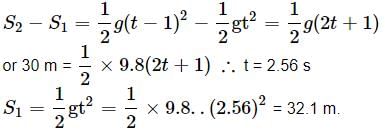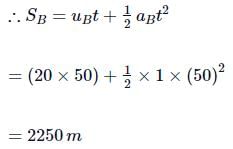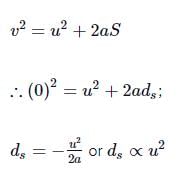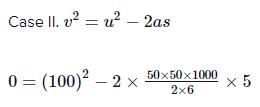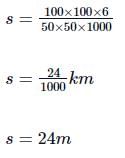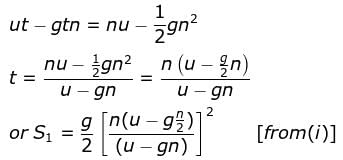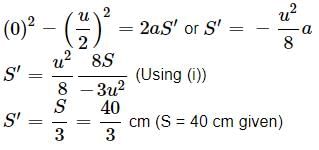Test: Kinematic Equations for Uniformly Accelerated Motion - NEET MCQ
30 Questions MCQ Test - Test: Kinematic Equations for Uniformly Accelerated Motion
A body starts from rest and moves with constant acceleration for t s. It travels a distance x1 in first half of time and x2 in next half of time, then
Free fall of an object in vacuum is a case of motion with
| 1 Crore+ students have signed up on EduRev. Have you? Download the App |
Which of the following equations does not represent the kinematic equations of motion?
Which of the following statements is not correct?
The distances covered by a freely falling body in its first, second, third,..., nth seconds of its motion
A body covers 20 m, 22 m, 24 m, in 8th, 9th and 10th seconds respectively. The body starts
A player throws a ball vertically upwards with velocity u. At highest point,
A car moving along a straight road with speed of 144 km/h is brought to a stop within a distance of 200 m. How long does it take for the car to stop?
An auto travelling along a straight road increases its speed from 30.0 m s-1 to 50.0 m s-1 in a distance of 180 m. If the acceleration is constant, how much time elapses while the auto moves this distance?
A body falling freely under gravity passes two points 30 m apart in 1 s. From what point above the upper point it began to fall? (Take g = 9.8 ms2).
A player throws a ball upwards with an initial speed of 30 m s−1. How long does the ball take to return to the player's hands? (Take g = 10 m s−2).
A girl standing on a stationary lift (open from above) throws a ball upwards with initial speed 50 m s-1. The time taken by the ball to return to her hands is (Take g = 10 ms-2)
A girl standing on a stationary lift (open from above) throws a ball upwards with initial speed 50 m s-1. if the lift starts moving up with a uniform speed of 5ms−1 and the girl again throws the ball up with the same speed, how long does the ball take to return to her hands?
It is a common observation that rain clouds can be at about 1 km altitude above the ground. If a rain drop falls from such a height freely under gravity, then what will be its speed in km h-1 (Take g = 10 m )
A man is standing on top of a building 100 m high. He throws two balls vertically, one at t = 0 and other after a time interval (less than 2 s). The later ball is thrown at a velocity of half the first. The vertical gap between first and second ball is 15 m at t = 2 s. The gap is found to remain constant. The velocities with which the balls were thrown are (Take g = 10 m s−2).
A body sliding on a smooth inclined plane requires 4 seconds to reach the bottom starting from rest at the top. How much time does it take to cover one-fourth distance starting from rest at the top
A ball is thrown vertically upwards with a velocity of 20 m s-1 from the top of a multistorey building of 25 m high. How high will the ball rise? (Take g = 10 m s-2)
A ball is thrown vertically upwards with a velocity of 20 m s-1 from the top of a multistorey building of 25 m high. the time taken by the ball to reach the ground is
Two trains A and B of length 400 m each are moving on two parallel tracks with a uniform speed of 72 km h-1 in the same direction, with A ahead of B. The driver of B decides to overtake A and accelerates by 1 ms-2. If after 50s, the guard of B just brushed past A, what was the original distance between them?
The velocity of a particle at an instant is 10 ms-1 After 3 s its velocity will becomes 16 ms-1. The velocity at 2 s, before the given instant will be
A body covers a distance of 4 m in 3rd second and 12 m in 5th second. If the motion is uniformly accelerated, how far will it travel in the next 3 seconds?
Stopping distance of a moving vehicle is directly proportional to
A car moving with a speed of 50 km h-1 can be stopped by brakes after atleast 6 m. If the same car is moving at a speed of 100 km h the minimum stopping distance is
An object falling through a fluid is observed to have acceleration given by a = g − bv where g = gravitational acceleration and b is constant. After a long time of release, it is observed to fall with constant speed. The value of constant speed is
A particle is released from rest from a tower of height 3h. The ratio of the intervals of time to cover three equal heights h is
A stone is dropped from the top of a tall cliff and n seconds later another stone is thrown vertically downwards with a velocity u. Then the second stone overtakes the first, below the top of the cliff at a distance given by
A motorcycle and a car start from rest from the same place at the same time and travel in the same direction. The motorcycle accelerates at 1.0ms−1 up to a speed of 36 kmh-1 and the car at 0.5 ms1 up to a speed of 54 kmh-1. The time at which the car would overtake the motorcycle is
A body initially at rest is moving with uniform acceleration a. Its velocity after n seconds is v. The displacement of the body in last 2 s is
A body A starts from rest with an acceleration a1. After 2 seconds, another body B starts from rest with an acceleration a2. If they travel equal distances in the 5th second, after the start of A, then the ratio a1 : a2, is equal to
A bullet fired into a fixed wooden block loses half of its velocity after penetrating 40cm. It comes to rest after penetrating a further distance of












